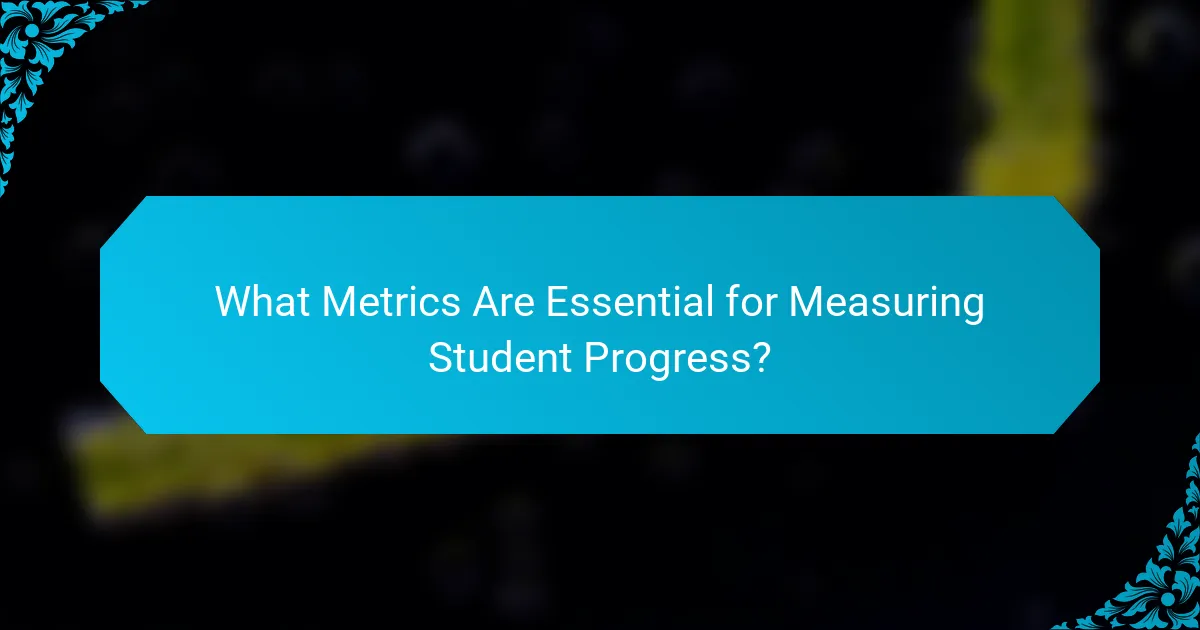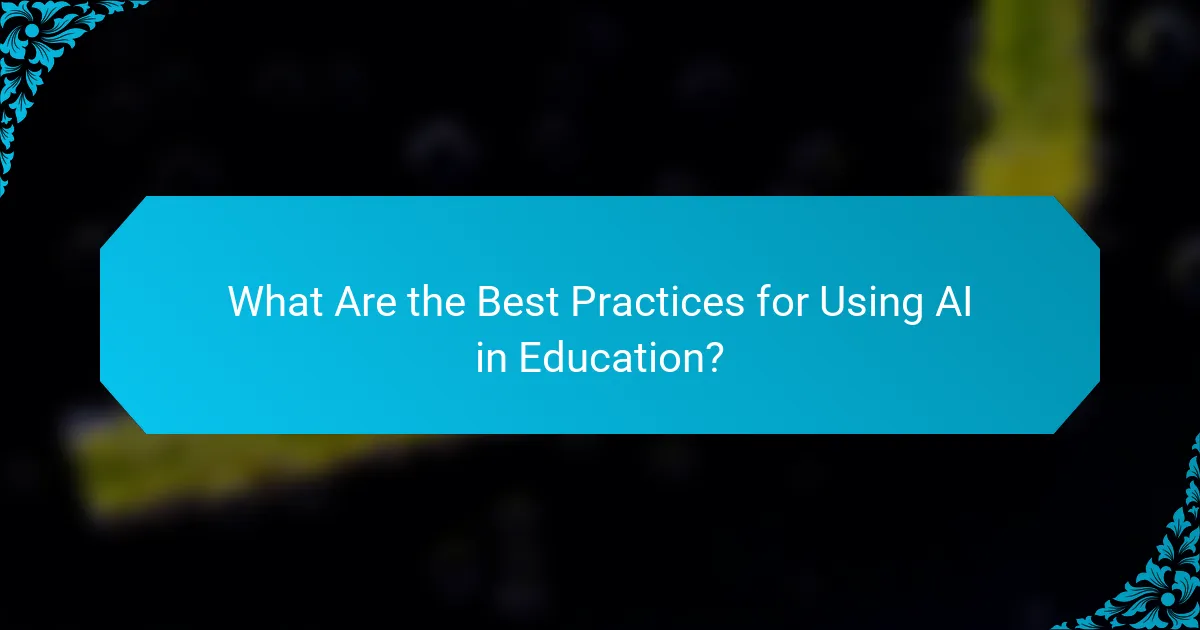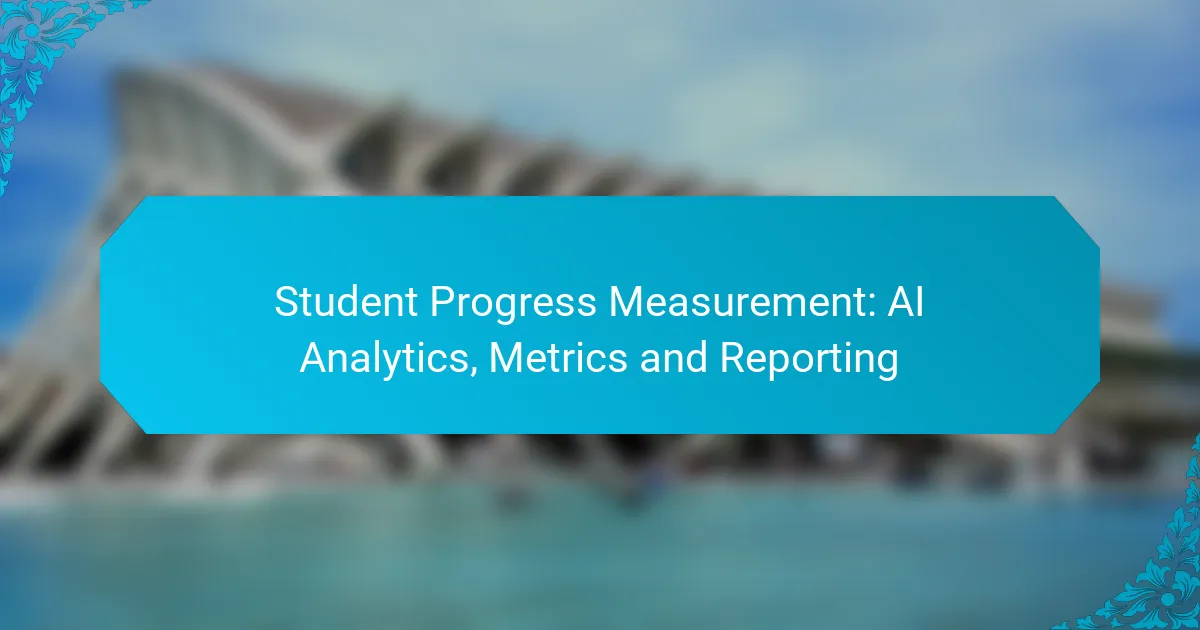AI analytics plays a crucial role in measuring student progress by delivering real-time insights and actionable data. By utilizing essential metrics such as academic performance scores and engagement levels, educators can gain a comprehensive understanding of each student’s learning journey, enabling them to tailor educational experiences effectively.

How Can AI Analytics Improve Student Progress Measurement?
AI analytics can significantly enhance student progress measurement by providing timely insights and actionable data. These technologies enable educators to track performance in real-time, predict future outcomes, and tailor learning experiences to individual needs.
Real-time data analysis
Real-time data analysis allows educators to monitor student performance as it happens. By utilizing AI tools, teachers can quickly identify trends, such as declining grades or engagement levels, and intervene promptly. This immediate feedback loop supports timely adjustments to teaching strategies and resource allocation.
For example, platforms that analyze attendance, assignment submissions, and participation can generate alerts for students who may need additional support. This proactive approach helps in addressing issues before they escalate.
Predictive performance insights
Predictive performance insights leverage historical data to forecast future academic outcomes. AI algorithms can analyze patterns in student behavior and performance, helping educators identify at-risk students early on. This foresight enables targeted interventions that can improve overall student success.
Schools can implement predictive analytics to assess factors like homework completion rates and test scores, allowing them to tailor support services effectively. For instance, if a student shows a consistent drop in performance, educators can provide personalized tutoring or counseling.
Personalized learning pathways
Personalized learning pathways created through AI analytics cater to the unique needs of each student. By analyzing individual learning styles, strengths, and weaknesses, AI can recommend customized resources and activities that enhance engagement and comprehension.
For instance, a student struggling with math concepts might receive targeted exercises and video tutorials that align with their learning pace. This individualized approach fosters a more effective learning environment and can lead to improved academic outcomes.
Automated reporting tools
Automated reporting tools streamline the process of tracking and communicating student progress. These tools can generate detailed reports on academic performance, attendance, and engagement levels without requiring extensive manual input from educators.
By using automated systems, schools can save time and reduce administrative burdens, allowing teachers to focus more on instruction. Additionally, these reports can be easily shared with parents and stakeholders, fostering transparency and collaboration in the educational process.

What Metrics Are Essential for Measuring Student Progress?
Essential metrics for measuring student progress include academic performance scores, engagement levels, attendance rates, and skill mastery assessments. These metrics provide a comprehensive view of a student’s learning journey and help educators identify areas for improvement.
Academic performance scores
Academic performance scores reflect a student’s understanding of the curriculum and are typically derived from grades on assignments, tests, and exams. These scores can be quantified on a standard scale, such as A-F or numerical grades, allowing for easy comparison among students.
To effectively use academic performance scores, educators should consider the weight of different assessments. For instance, major exams might account for a larger percentage of the final grade than quizzes. Regularly reviewing these scores can help identify trends and inform instructional strategies.
Engagement levels
Engagement levels measure how actively students participate in their learning environment. This can be assessed through participation in class discussions, completion of assignments, and involvement in extracurricular activities. High engagement often correlates with better academic outcomes.
To gauge engagement, educators can use tools like surveys or observation checklists. It’s important to look for patterns over time, as fluctuating engagement may indicate changes in a student’s motivation or external factors affecting their learning.
Attendance rates
Attendance rates indicate how frequently students attend classes, which is crucial for their academic success. Consistent attendance is linked to higher performance, while chronic absenteeism can hinder learning and lead to gaps in knowledge.
Tracking attendance can be done through school management systems that log daily presence. Educators should aim for attendance rates above 90% to ensure students are receiving adequate instruction. Interventions may be necessary for students with low attendance to address underlying issues.
Skill mastery assessments
Skill mastery assessments evaluate a student’s proficiency in specific competencies or learning objectives. These assessments can take various forms, including quizzes, projects, or standardized tests, and help determine whether students have acquired the necessary skills.
When implementing skill mastery assessments, it is beneficial to use a variety of assessment types to capture a well-rounded view of student abilities. Setting clear benchmarks for mastery can guide instruction and provide students with targeted feedback for improvement.

How to Implement Effective Reporting Systems?
Implementing effective reporting systems involves selecting appropriate tools, integrating diverse data sources, and creating user-friendly dashboards. These components work together to provide clear insights into student progress and performance metrics.
Choosing the right software
Selecting the right software is crucial for effective reporting. Look for platforms that offer customizable reporting features, user-friendly interfaces, and compatibility with existing systems. Popular options include tools like Tableau, Power BI, and Google Data Studio.
Consider your institution’s specific needs, such as budget constraints and the scale of data processing. Many software solutions offer tiered pricing models, making it easier to find one that fits your financial parameters.
Integrating data sources
Integrating various data sources is essential for comprehensive reporting. This may include student information systems, learning management systems, and assessment tools. Ensure that the software you choose can seamlessly connect with these sources to pull relevant data automatically.
Establish a clear data governance policy to maintain data integrity and security. Regularly audit your data sources to ensure they are up-to-date and accurate, which will enhance the reliability of your reports.
Setting up dashboards
Setting up dashboards requires careful planning to ensure they effectively communicate key metrics. Focus on visual clarity by using graphs, charts, and tables that highlight important trends and comparisons. Prioritize the metrics that matter most to stakeholders, such as student engagement and academic performance.
Regularly update your dashboards to reflect the latest data and insights. Solicit feedback from users to improve usability and relevance, ensuring that the dashboards remain effective tools for monitoring student progress.

What Are the Best Practices for Using AI in Education?
Best practices for using AI in education focus on enhancing student learning while ensuring ethical and effective implementation. Key strategies include prioritizing data privacy, establishing continuous feedback loops, and training educators to effectively use AI tools.
Data privacy considerations
Data privacy is crucial when implementing AI in educational settings. Schools must ensure compliance with regulations like FERPA in the U.S. or GDPR in Europe, which protect student information. This includes obtaining consent for data collection and ensuring that data is stored securely.
To safeguard student data, institutions should conduct regular audits of their AI systems and limit access to sensitive information. Using anonymization techniques can also help protect individual identities while still allowing for valuable insights from aggregated data.
Continuous feedback loops
Establishing continuous feedback loops is essential for improving AI-driven educational tools. These loops involve regularly collecting data on student performance and engagement, which can then be analyzed to refine AI algorithms and instructional strategies. This iterative process helps educators adapt their teaching methods based on real-time insights.
For effective feedback, schools can implement periodic assessments and surveys to gauge student understanding and satisfaction. This information can inform adjustments to AI tools, ensuring they meet the evolving needs of students.
Training educators on AI tools
Training educators on AI tools is vital for maximizing their potential in the classroom. Teachers should receive comprehensive training that covers both the technical aspects of the tools and their pedagogical applications. This ensures that educators can integrate AI effectively into their teaching practices.
Professional development programs can include workshops, hands-on training sessions, and ongoing support. Schools should encourage collaboration among teachers to share best practices and experiences, fostering a community of learning around AI in education.

What Challenges Do Schools Face in Progress Measurement?
Schools encounter several challenges in measuring student progress, including data accuracy issues, resistance to technology adoption, and resource allocation constraints. These obstacles can hinder the effective use of AI analytics and metrics for tracking educational outcomes.
Data accuracy issues
Data accuracy is critical for reliable progress measurement, yet many schools struggle with inconsistent data collection methods. Errors in data entry, outdated information, or lack of standardized metrics can lead to misleading conclusions about student performance.
To improve data accuracy, schools should implement regular audits of their data systems and provide training for staff on best practices in data management. Utilizing automated data collection tools can also minimize human error and enhance the reliability of the information gathered.
Resistance to technology adoption
Resistance to adopting new technologies can significantly impede progress measurement efforts. Educators and administrators may be hesitant to embrace AI analytics due to concerns about complexity, training requirements, or potential disruptions to existing workflows.
To overcome this resistance, schools should focus on demonstrating the benefits of technology through pilot programs and success stories. Providing ongoing support and professional development can also help ease the transition and encourage staff to engage with new tools.
Resource allocation constraints
Limited resources often restrict schools’ ability to invest in advanced progress measurement systems. Budget constraints may prevent the acquisition of necessary technology or the hiring of skilled personnel to analyze data effectively.
Schools can address these constraints by prioritizing funding for essential tools and exploring partnerships with local organizations or educational technology companies. Additionally, leveraging free or low-cost analytics platforms can provide valuable insights without straining budgets.

How to Choose the Right AI Analytics Platform?
Selecting the right AI analytics platform involves assessing your specific needs, the platform’s capabilities, and its compatibility with existing systems. Focus on features that enhance student progress measurement, such as real-time reporting, customizable metrics, and user-friendly interfaces.
Key Features to Look For
When evaluating AI analytics platforms, prioritize features that directly support educational goals. Look for tools that offer real-time data analysis, customizable dashboards, and integration capabilities with existing Learning Management Systems (LMS). These features can significantly enhance your ability to track student progress effectively.
Additionally, consider platforms that provide predictive analytics. This functionality can help identify at-risk students early, allowing for timely interventions. Ensure that the platform supports various data sources, including grades, attendance, and engagement metrics.
Cost Considerations
Cost is a crucial factor when choosing an AI analytics platform. Prices can vary widely, typically ranging from a few hundred to several thousand dollars per month, depending on the features and scale of use. Assess your budget and consider platforms that offer tiered pricing or pay-as-you-go models to avoid overspending.
Also, factor in potential hidden costs such as training, maintenance, and integration with other systems. A platform that appears affordable upfront may incur additional expenses that could impact your overall budget.
User Experience and Support
A platform’s user experience can greatly influence its effectiveness. Look for intuitive interfaces that require minimal training for staff and students. Platforms with strong user support, including tutorials, live chat, and community forums, can enhance the overall experience and ease the transition.
Evaluate customer reviews and case studies to understand how well the platform performs in real-world educational settings. A responsive support team can be invaluable, especially when troubleshooting issues or implementing new features.
